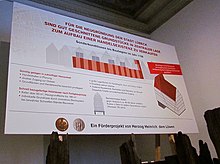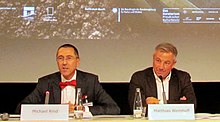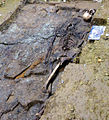Turbulent times. Archeology in Germany
Turbulent times. Archeology in Germany was an archeology exhibition from September 21, 2018 to January 6, 2019 in Berlin , which took place on the occasion of the European Cultural Heritage Year 2018. In the Martin-Gropius-Bau it showed the most important archaeological finds of the last 20 years in Germany , from the Paleolithic 300,000 years ago to the 20th century. The exhibition, which lasted over three months, had 120,000 visitors.

subjects
With the finds from Germany, the exhibition had a national perspective that it expanded to include Europe . Using the exhibits from all epochs of human history , she wanted to show that the area of today's Germany has always been integrated into a pan-European network and that the foundations for a common Europe were laid several thousand years ago. The title Moving Times should make it clear that there has been an intense movement of people and things at all times.
The exhibition was not arranged chronologically in epochs, but divided into the subject areas of mobility , conflict , exchange and innovation . According to the exhibition curator and Berlin state archaeologist Matthias Wemhoff , these topics are "what once connected the nervous continent of Europe ...". The topic of mobility was about migration , in which people left their homeland for various reasons and whose paths are archaeologically tangible through legacies. Among other things, four major migratory events in the Neolithic Age that shaped the gene pool of Europeans were highlighted. The topic of conflict showed that Europe has been shaped by armed conflicts up to the present day and that this can be demonstrated in an organized form for the first time in the Bronze Age . In the exhibition area on the subject of exchange, the focus was on the movement of goods , which took place in Europe in complex exchange systems and through extensive networks as early as the Neolithic. Using exhibits, raw material extraction, distribution and trading as well as the resulting social and urban development changes were highlighted. The topic of innovation showed the effects of progress in technical and spiritual terms on everyday life as well as on production and warfare , as many innovations can be archaeologically proven.
Exhibits

Around 1000 exhibits from 300 complexes of finds from 16 federal states were shown in the exhibition . With a few exceptions, including France and Poland, they came from sites in what is now Germany. It was almost exclusively new finds from the last 20 years; the few old finds were reassessed against the background of the exhibition. The exhibits were made available on loan from 70 institutions, including the paläon , the Lower Saxony State Museum Hanover , the Oldenburg State Museum for Nature and Man , the Erding Museum , the Quintana Museum , the Hamburg Archaeological Museum and the Federseemuseum . Only 379 finds from Schleswig-Holstein steered the Archaeological Museum Schloss Gottorf in. Some of the exhibits were transported to Berlin with air-conditioned forwarding vehicles and in specially made air-conditioned boxes. The return transport of the exhibits took place in early 2019.
The four exhibition themes mobility, conflict, exchange and innovation were presented on the ground floor of the Martin-Gropius-Bau on an area of 1600 m². The central area of the exhibition was the around 800 m² atrium around which the rooms for the individual subject areas were grouped. The focal point of the exhibition was found in the atrium from the port area of Roman Cologne ( Colonia Claudia Ara Agrippinensium ) . The central exhibit was an almost 2000 year old section of the harbor wall as a 12 meter long and 3.5 meter high sheet piling made of 22 oak planks. The most spectacular exhibit was the Nebra Sky Disc , which was presented as a highlight in a darkened room with three Bronze Age gold hats. The sky disk is usually not borrowed and left the State Museum of Prehistory in Halle for the first time in over ten years . She is said to have been insured with 100 million euros. Around 200 exhibits from Lübeck's founding quarter represented medieval trade. For this purpose, the exhibition had its own room, which was reproduced on two sides of a medieval cellar made of standardized wooden parts that was discovered in 2009. In another room, members of the Lübeck youth construction works worked on oak trunks in order to make a replica of the wooden cellar for the museum visitors.
Special exhibits and finds
- Nebra Sky Disc (original until November 5, 2018)
- Harbor wall of Roman Cologne
- A Schöninger spear
- Goldhort von Gessel (complete from December 11, 2018)
- Gold hats from Berlin , Schifferstadt and Avanton
- Gold coins from Biesenbrow
- Treasure of gold from Profen
- Barbarian treasure from Rülzheim
- Copper hoard from Lüstringen
- Hoard from Lebus
- Bar hoard from Oberding
- Hoard from Dieskau
- Venus from the hollow rock
- Venus of Bierden
- Berlin sculpture find
- Copper hatchet from Steinbergen
- A Stader bronze wheel
- Disc wheels from Glum
- Hand of the girl from the Uchter Moor
- Horse head from Waldgirmes (November 7th to December 17th, 2018)
- Ulfberhtschwert von Großenwieden
- Spatha of the Frankish prince Arpvar
- Engraved slate from Gönnersdorf
- Ivory comb from the Holsterburg
- Reconstructed Kline from the Roman camp Haltern
- Warrior grave of " Lord von Boilstädt "
- Grave of " Lord von Morken "
- Grave finds of the " Celtic Duchess of Herbertingen "
- Finds from the Herxheim mine
- Finds from the Thorsberger Moor
- Finds from the medieval mine in Rammelsberg
- Finds from the Harzhorn event
- Finds from the battlefield in the Tollensetal
- Finds from the leaf cavity
- Pathways from the Aschener and Campemoor
- Wreckage from the Princess Hedvig Sophia and the Lindormen
- Individual exhibits
- Warrior grave of " Lord von Boilstädt "
organization

The organizers of the exhibition were the Association of State Archaeologists and the Berlin Museum of Prehistory and Early History , whose director Matthias Wemhoff was in charge of the conception. The show was sponsored by the Federal Government Commissioner for Culture and the Media and the Prussian Cultural Heritage Board of Trustees as a supporter of the Prussian Cultural Heritage Foundation.
The official opening on September 20, 2018 in the Berlin House of Representatives was made by Federal President Frank-Walter Steinmeier in the presence of Federal Council Chairman Michael Müller . The Federal President, who was also the patron of the exhibition, opened his speech with the words “Sous les pavés, la plage” (“The beach lies under the pavement”). With the quote as one of the slogans of the Situationist International , he addressed the hidden secrets beneath the surface of the earth.
After 1975 the show was in Cologne with The New Image of the Old World and after 2003 in Bonn and Berlin with People - Times - Spaces. Archeology in Germany the third nationwide archeology exhibition and the second, in which all state archaeologists participate.
To the accompanying program of the exhibition Moving Times. Archeology in Germany included events in the Martin-Gropius-Bau and guided tours in historic Berlin and archaeological workshops by the monument preservation department of the Berlin State Monuments Office .
After the exhibition ended, the Association of State Archaeologists announced that it had 120,000 visitors and that this is considered a visitor record. Around 500 tours took place and the exhibition catalog with a print run of 8,000 was out of print.
reception
According to the organizers, the exhibition did not want to be a mere performance show of German archeology, but the media consistently characterized it as such. According to the weekly newspaper Die Zeit , because of the high-ranking exhibits, it is an “archeology show of superlatives”. The Süddeutsche Zeitung rated the exhibition as "by and large an overwhelming show". According to the news magazine Der Spiegel, it is one of the “most spectacular special exhibitions” in Germany to date.
criticism
The journalist and art scholar Nikolaus Bernau saw “a great exhibition, not least because of the staging that can also inspire children” and placed the exhibition in the context of the current political climate of xenophobia. Within the exhibition, Bernau saw gaps in modern archeology of the 20th century, as there were no finds from thoroughly examined Nazi forced labor camps or special camps in the Soviet occupation zone . The art critic Carsten Probst complained that an intellectual evaluation was actually completely lacking; the show would only offer a lot to the eye. Wulf Rüskamp wrote that the visitor would like to find out more about the numerous exhibits, which was left to the very well-made catalog. Although the exhibition is about archeology in Germany, including national archeology until the 1960s, there was no self-reflection of the subject and a contextualization of the archaeological finds at different times.
literature
- Matthias Wemhoff, Michael Rind (ed.): Moving times - archeology in Germany. , Petersberg, 2018, ISBN 978-3-7319-0723-7 (exhibition catalog)
- Stephan Lehmann : A German “Performance Show”: An Exhibition in Search of a European Image of History , in: American Journal of Archeology No. 123, No. 3 (July 2019), pp. 513-521. ( Online , pdf)
- Frank Siegmund: "Moving Times: Archeology in Germany" in: Archaeological Information of the German Society for Prehistory and Early History , Vol. 42, 2019, pp. 502–510 (review, online )
- Jutta Zerres: Deceived. For the exhibition "Moving Times. Archeology in Germany" in Berlin. ArchaeoZeit (December 30, 2018 )
Web links
- Exhibition website
- Brief description of the exhibition on kulturreise-ideen.de
- 33 press photos of exhibits
- 13 photos of exhibits in Der Spiegel from September 21, 2018
- Turbulent times. Archeology in Germany. Interview with Prof. Dr. Matthias Wemhoff In: museumsfernsehen.de from September 14, 2017 and the same video on YouTube (3:27 minutes)
- A history of human migration at Deutschlandfunk Kultur on September 20, 2018
- "Our entire development is based on migration". Matthias Wemhoff in conversation with Stephan Karkowsky at Deutschlandfunk Kultur on September 20, 2018
- Berthold Seewald: The cannibals from Herxheim and other skulls at Welt Online from September 21, 2018
- Seven audio contributions on details and the concept of the exhibition by curators
Individual evidence
- ↑ Uta Baier: Sky Disc moves to Berlin in Volksstimme of September 14, 2018
- ↑ Turbulent times. Archeology in Germany at sharingheritage.de
- ↑ a b c A Schöninger spear becomes the star of Berlin in Helmstedter Nachrichten on September 14, 2018
- ↑ Saxony's archeology treasures will be shown in the Berlin exhibition at sachsen.de from September 20, 2018
- ↑ Migration is the beginning of all developments at tagesschau.de from September 26, 2018
- ↑ a b Berlin is planning a superlative archeology show on Focus Online on March 22, 2018
- ↑ Exhibition “Moving Times” - “Archeology has no national dominant culture” on ZDF today from September 22, 2018
- ↑ Stars from the underground at Welt online from January 8, 2018
- ↑ a b c d Outstanding finds from Westphalia travel to Berlin archeology exhibition at Focus Online on August 9, 2018
- ↑ Ticket sales for the archeology show will start in Tagesspiegel from March 23, 2018
- ↑ State Museum sends bikes on their journey in Nordwest-Zeitung on August 29, 2018
- ↑ Erdinger archeology treasures start their trip to Berlin in Münchner Wochenanzeiger from September 1, 2018
- ^ Künzinger finds are exhibited in Berlin in the Wochenblatt on August 17, 2018
- ↑ Vera Fengler: Exhibition: How to dust off archeology in Hamburger Abendblatt from September 27, 2018
- ↑ Mysterious mask from the moor goes on a journey in Swabian from September 13, 2018
- ↑ Exhibition “Moving Times. Archeology in Germany “September 21, 2018 to January 6, 2019 , media information on the Schleswig-Holstein state portal
- ↑ Turbulent times. Archeology in Germany at the Lower Saxony State Office for Monument Preservation
- ↑ Archaeological finds from Freising in Berlin in Süddeutsche Zeitung from August 28, 2018
- ^ Returned safe and sound in the Süddeutsche Zeitung on February 13, 2019
- ↑ Christoph Mohr: Cologne Shards in Berlin - The large archeology exhibition "Moving Times" shows finds from the underground construction in report-K from December 6, 2018
- ↑ Turbulent times. Archeology in Germany at the Roman-Germanic Museum
- ↑ Rolf Brockschmidt: People never sat still in Tagesspiegel of September 22, 2018
- ↑ Nebra Sky Disc in Berlin ( Memento of the original from September 13, 2018 in the Internet Archive ) Info: The archive link was inserted automatically and has not yet been checked. Please check the original and archive link according to the instructions and then remove this notice. in the time of December 23, 2017
- ↑ Geraldine Oetken: "Moving Times": Exhibition in Berlin shows the most spectacular archeological finds in Hannoversche Allgemeine Zeitung on September 26, 2018
- ↑ Lübeck sends treasures from the founding quarter to Berlin in Lübecker Nachrichten of March 13, 2018
- ↑ Astrid Wulf New old Lübeck wood cellar moves to Berlin at ndr.de on August 27, 2018
- ↑ a b Turbulent times. Archeology in Germany. 09/21/2018 to 01/06/2019. Gropius Bau
- ↑ Goldhort von Gessel as of today completely in the exhibition “Moving Times. Archeology in Germany ” at the Staatliche Museen zu Berlin on December 11, 2018
- ↑ News from August 30, 2018 at Focus Online from August 30, 2018
- ↑ Marieluise Denecke: Steinberger Kupferbeil in Berlin can be seen in the Schaumburger Zeitung on November 14, 2018
- ↑ Archaeological Museum Krefeld with exhibits in the Berlin exhibition - Franconian prince sword and reconstruction are on loan from Focus Online from September 19, 2018
- ↑ Klaus Krämer: Spectacular early Celtic find travels to Berlin at Deutsche Welle on September 17, 2018
- ↑ Benjamin Wehry / Susanne Kuprella: Turbulent times. Archeology in Germany Event announcement near Hanover historical
- ↑ Karolin Korthase: Who were we and if so, how many? Turbulent times in archeology in the blog of the Staatliche Museen zu Berlin
- ^ Opening of the exhibition “Moving Times” at bundespräsident.de on September 20, 2018
- ↑ Lübscher Holzkeller travels to Berlin in Lübecker Nachrichten of August 28, 2018
- ↑ President of the Federal Council at the opening of the exhibition "Turbulent Times"
- ↑ Wooden cellar from the 12th century among the highlights of the exhibition "Moving Times" in focus online from September 28, 2018
- ↑ Insight from waste in Der Spiegel of July 7, 1975
- ↑ People - times - spaces. Archeology in Germany. December 6, 2002 to March 31, 2003
- ^ Nebra sky disk in Berlin in Westfälische Nachrichten of December 23, 2017
- ↑ Klaus Krämer: Archaeological Treasures from German Earth - Exhibition shows spectacular finds at Deutsche Welle on September 21, 2018
- ^ Gropius Bau. Turbulent times. Archeology in Germany. Accompanying program
- ↑ Accompanying program for the exhibition "Moving Times - Archeology in Germany" at sharingheritage.de
- ↑ Susanne Kuprella: Exhibition “Moving Times. Archeology in Germany "in Berlin's Martin-Gropius-Bau ends with a record number of visitors at the Association of State Archaeologists on January 24, 2019
- ↑ a b Wulf Rüskamp: Archeology in Germany: An exhibition in Berlin takes stock in Badische Zeitung on October 30, 2018
- ↑ Venus and Sky Disc: Superlative archeology show in Die Zeit on September 20, 2018
- ↑ Cosima Lutz: Superlative archeology show in Berlin in Berliner Morgenpost on September 21, 2018
- ↑ Because of the "good old days" in the Süddeutsche Zeitung of October 26, 2018
- ↑ War in the Blood in: Der Spiegel No. 39 of September 21, 2018, p. 102, Online: Guido Kleinhubbert: Homo brutalis, the first German of September 21, 2018 (payment barrier)
- ↑ Nikolaus Bernau: Archeology exhibition Man does not have roots, he moves in Berliner Zeitung from September 20, 2018
- ↑ a b Carsten Probst: Moving Times. Archeology in Germany - Exhibition at Gropius Bau Berlin on Deutschlandfunk from September 20, 2018 (mp 3 on demand)
- ↑ Uta Luise Zimmermann-Krause: Book tip: "Moving Times - Archeology in Germany"
Coordinates: 52 ° 30 '25.4 " N , 13 ° 22' 54.5" E
















